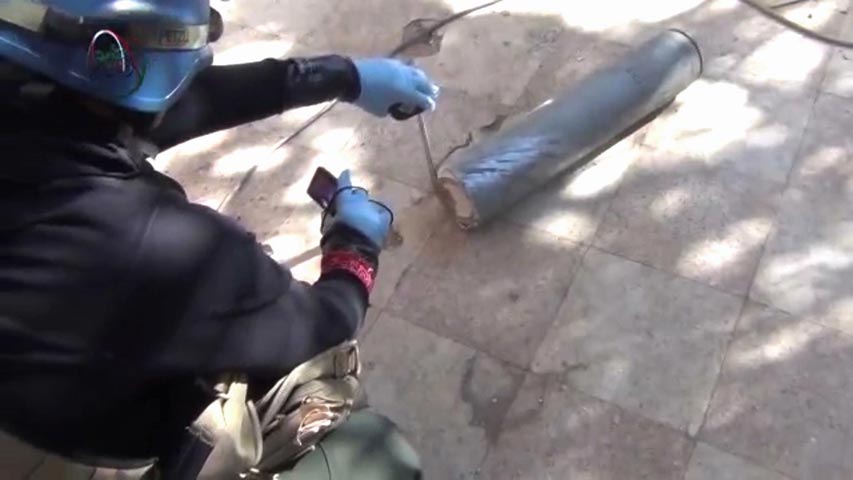An alleged deadly chemical attack on a rebel-held Damascus neighbourhood likely used the potent nerve poison sarin, delivered by missiles designed to lob lethal cargo from greater distances.

The U.N.’s special envoy to Syria said Wednesday a chemical “substance” was used in an attack last week that killed hundreds of people and wounded thousands more.
In doing so, Bashar al-Assad’s government would have crossed a “red line” using a tool that’s been in the regime’s arsenal for a long time.
“It’s been well-known for over two decades that Syria has chemical weapons, including nerve gases,” said Royal Military College professor Walter Dorn.
That includes both sarin and the nerve agent VX, Dorn said. In this case, “I think it’s more likely to be sarin.”
Sarin is a binary weapon: It contains two chemicals which are activated and react to become sarin after they’ve been mixed.
- Budget 2024 failed to spark ‘political reboot’ for Liberals, polling suggests
- Peel police chief met Sri Lankan officer a court says ‘participated’ in torture
- Wrong remains sent to ‘exhausted’ Canadian family after death on Cuba vacation
- Liberals having ‘very good’ budget talks with NDP, says Freeland
“We know that they were mixed many months ago. There is a limited shelf life, so there is a use-them-or-lose-them challenge for the regime,” Dorn said.
The medical relief organization Médecins Sans Frontières said Saturday that it had reports of 3,600 people being treated for neurotoxic symptoms, of whom 355 had died.
Doctors reported “symptoms including convulsions, excess saliva, pinpoint pupils, blurred vision and respiratory distress,” MSF said.
For governments looking for a weapon of mass destruction, a chemical arsenal can be cheaper and easier to create than nuclear weapons.
“‘The poor man’s atomic bomb,’ is what it’s been called,” Dorn says. “Nuclear weapons require many years of programs and a high level of sophistication. It’s a very delicate process, whereas chemical weapons are pretty easy. You could make them in any university, or any research facility. There are two ingredients that are the precursors for sarin, and one of them is simply rubbing alcohol.”
(The second ingredient, methylphosphonyl difluoride, was among several chemicals then-President Ronald Reagan banned for export to Syria in 1986)
Syria’s chemical weapons were developed to counter Israel’s nuclear arsenal, Dorn says: “They were trying to deter one type of weapon of mass destruction with another.”
Last week’s attack has escalated the crisis over Syria’s civil war. The United States, having said that the use of chemical agents by Syria would be a “red line,” seemed Tuesday to be heading toward some form of military response.
British Prime Minister David Cameron recalled Parliament to discuss the possibility of military action; Canadian Prime Minister Stephen Harper, who announced a fall prorogation last week, is under pressure to do the same.
U.N. Syria envoy Lakhdar Brahimi, who told reporters in Geneva there’s evidence the regime used chemical weapons, also noted international law dictates that any military strike on Syria needs U.N. Security Council approval.
The UN Security Council meets to discuss the situation Wednesday afternoon. Previous attempts at Security Council action have been stymied or vetoed by Russia and China.
Syria is suspected of having one of the world’s largest chemical weapons arsenals, including mustard and nerve gas, such as sarin.
Sarin was originally developed in the 1930s in Germany as an insecticide. It’s less toxic than VX vapour, but 25 times more powerful than hydrogen cyanide. It was used in a 1995 attack on the Tokyo subway system.
Syria has had the ability to produce its own sarin in converted agrochemical factories since the 1980s, according to the Nuclear Threat Initiative, and has been able to obtain the ingredients despite a decades-old ban on their sale.
Watch: Dr. Walter Dorn from the Royal Military College breaks down the alleged large-scale chemical weapons used in Syria.
Chemical weapons can be delivered by artillery shells, but missiles offer the chance to be very far away from the chemical agent when it goes off, Dorn said.
“It’s trajectory, too – it’s an urban area, and if you want to hit the ground, you can’t go through a whole lot of buildings. You have to shoot it high in the air and have it come down in a relatively vertical fashion.”
Although sarin dissipates quickly, the area won’t be safe to enter without protective equipment for months, he warns.
“The danger that there’s a little pool, even though it’s highly volatile, and it’s going to be causing symptoms in your soldiers. If you had gas masks, you could go in hours afterwards.”
For its part, the Syrian regime denies responsibility for the attack, but Dorn says the rebels probably don’t have the capability for a missile attack on that scale. In any case, they control the area where the gas was apparently deployed.
In May, UN investigator Carla Del Ponte raised the possibility that the Syrian rebels had also been responsible for chemical attacks.
“Allegations have been received concerning the use of chemical weapons by both parties,” said a UN report in June. “The majority concern their use by Government forces … It has not been possible, on the evidence available, to determine the precise chemical agents used, their delivery systems or the perpetrator.”
If the U.S. or other countries resort to air attacks, they could face the nightmarish possibility that bombings intended to punish the regime for inflicting chemical attacks might release more chemical agents, Dorn said.
“When the war broke out, the Syrian chemical weapons were dispersed in 15 or more locations, and they had manufacturing plants as well. In this case, attacking certain facilities could be very dangerous, because you could be causing the exact thing that you want to prevent, which is the release of chemical weapons into the atmosphere.”
With files from the Associated Press and Anna Mehler Paperny




Comments